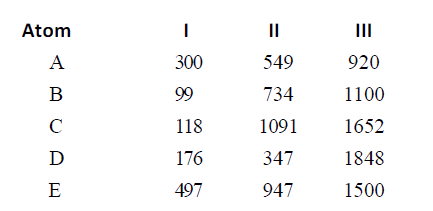Why are fluorine and oxygen compounds called oxygen fluorides?
To understand why compounds of fluorine and oxygen are called oxygen fluorides, we can break down the explanation into several steps:
Step 1: Understanding Electronegativity
Electronegativity is the tendency of an atom to attract shared electrons in a chemical bond. In this context, we need to compare the electronegativities of fluorine and oxygen.
Step 2: Comparing Fluorine and Oxygen
Fluorine is the most electronegative element in the periodic table, while oxygen is also highly electronegative but less so than fluorine. This means that in a bond between fluorine and oxygen, fluorine will attract the shared electrons more strongly than oxygen.
Step 3: Naming Conventions in Chemistry
In chemical nomenclature, the convention is to name the electropositive element (the one with lower electronegativity) first, followed by the electronegative element (the one with higher electronegativity).
Step 4: Determining Oxidation States
In compounds formed between fluorine and oxygen, fluorine typically assumes a negative oxidation state due to its high electronegativity. Conversely, oxygen will have a positive oxidation state in these compounds.
Step 5: Conclusion
Since fluorine is more electronegative than oxygen, the compounds are named with oxygen first, followed by fluorine. Therefore, they are referred to as "oxygen fluorides."
Final Answer
Compounds of fluorine and oxygen are called oxygen fluorides because fluorine is more electronegative than oxygen, leading to the naming convention where the less electronegative element (oxygen) is named first.
---
Electronegativity is the tendency of an atom to attract shared electrons in a chemical bond. In this context, we need to compare the electronegativities of fluorine and oxygen.
Fluorine is the most electronegative element in the periodic table, while oxygen is also highly electronegative but less so than fluorine. This means that in a bond between fluorine and oxygen, fluorine will attract the shared electrons more strongly than oxygen.
In chemical nomenclature, the convention is to name the electropositive element (the one with lower electronegativity) first, followed by the electronegative element (the one with higher electronegativity).
In compounds formed between fluorine and oxygen, fluorine typically assumes a negative oxidation state due to its high electronegativity. Conversely, oxygen will have a positive oxidation state in these compounds.
Since fluorine is more electronegative than oxygen, the compounds are named with oxygen first, followed by fluorine. Therefore, they are referred to as "oxygen fluorides."
Compounds of fluorine and oxygen are called oxygen fluorides because fluorine is more electronegative than oxygen, leading to the naming convention where the less electronegative element (oxygen) is named first.
Topper's Solved these Questions
- P-BLOCK ELEMENTSBOOK - ICSECHAPTER - P-BLOCK ELEMENTSEXERCISE - EXERCISE (PART-II)(DESCRIPTIVE QUESTIONS)(SHORT ANSWER QUESTIONS)
67 Videos
- P-BLOCK ELEMENTSBOOK - ICSECHAPTER - P-BLOCK ELEMENTSEXERCISE - EXERCISE (PART-II)(DESCRIPTIVE QUESTIONS)(LONG ANSWER QUESTIONS)
65 Videos
- P-BLOCK ELEMENTSBOOK - ICSECHAPTER - P-BLOCK ELEMENTSEXERCISE - EXERCISE (PART-I)(MATCH THE FOLLOWING)
1 Videos
- ORGANIC COMPOUNDS CONTAINING NITROGENBOOK - ICSECHAPTER - ORGANIC COMPOUNDS CONTAINING NITROGENEXERCISE - ISC EXAMINATION QUESTIONS ( PART-II DESCRIPTIVE QUESTIONS)
33 Videos
- POLYMERS BOOK - ICSECHAPTER - POLYMERS EXERCISE - ISC EXAMINATION QUESTIONS
10 Videos
Similar Questions
Knowledge Check
Predict the formula of the stable binary compounds that would be formed by the combination of the following pairs of elements.
a.Lithium and oxygen
b. Magnesium and nitrogen
c. Aluminium and iodine
d. Silicon and oxygen
e. Phosphorus and fluorine
f. Element 71 and fluorineAMgN2,SiO2BMg3N2,SiO2CMg2N3,Si2O3DMgN,SiO2
Ionization energies of five elements in kcal/mol are given below:
 .
.
If B react with fluorine and oxygen, the molecular formula of fluoride and oxide will be respectively :
View SolutionGive reasons for the following:
(i) Binary compounds of oxygen and fluorine are called fluorides.
(ii) Fluorine forms only one oxoacid HOF.
(iii) Noble gases have very low melting and boiling points.
View SolutionCan we estimate oxygen in a compound ?
View SolutionFluorine provides the largest variety of interhalogen compounds among halogens, why?
View SolutionWhich of the folowing compounds liberates oxygen on heating?
View SolutionWhy fluorine is most reactive?
View SolutionPredict the formula of the stable binary compounds that would be formed by the combination of the following pairs of elements.
a.Lithium and oxygen
b. Magnesium and nitrogen
c. Aluminium and iodine
d. Silicon and oxygen
e. Phosphorus and fluorine
f. Element 71 and fluorine
View Solution
